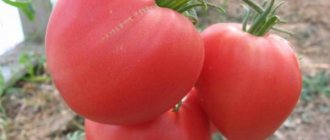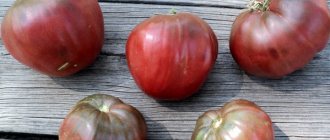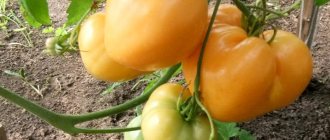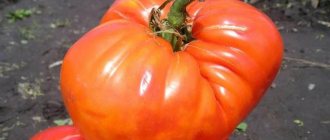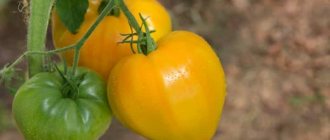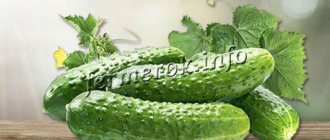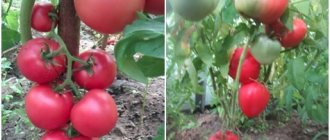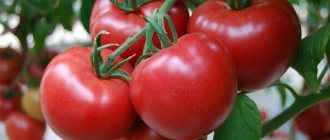If you are a fan of varieties with large fruits, then the Eagle Heart tomato will not leave you indifferent. Huge, pink-skinned tomatoes weighing under 1 kg can feed a family of four, with some left over for guests.
Let's give a description of the Eagle Heart tomato variety, talk about its yield, disease resistance and other qualities. We will also share some secrets of agricultural technology, without which the tomatoes will not turn out so tasty and large.
Description of the variety
Eagle Heart is a tomato variety bred by domestic breeders from Siberia. Its originator is Dereko Vladimir Nikolaevich.
The variety was bred in 2003 . In 2005, it was registered in the Russian register of selection achievements.
Tomato is actively grown by gardeners in all countries of the former CIS. Its seeds can also be found in online stores in Europe.
Distinctive features
The main feature of the Eagle Heart is its unusual fruits . They have a rich pink color, and the shape resembles a heart or large garden strawberry. The variety is also impressive for its size. The weight of individual berries reaches 1 kg. Moreover, all the tomatoes on the bush turn out to be large. The taste of Eagle Heart is rich, sweet, with slightly pronounced sourness.
This type of tomato rarely causes allergies . It is recommended for baby food. The fruits contain lycopene, which helps cleanse the body of waste, toxins, free radicals and bad cholesterol, and iodine, which is necessary for the normal functioning of the thyroid gland.
The bush is indeterminate and tall , so staking and pinching are necessary.
Like all varieties of Siberian selection, Eagle Heart is resistant to temperature changes . Tomatoes are grown in open and protected ground.
Important! The downside of this variety is that it is demanding on soil composition. The gardener will have to constantly fertilize, monitoring the amount of nitrogen fertilizer.
Main characteristics
The Eagle Heart tomato is planted by gardeners all over the world. Its main characteristics and description of the variety are given in the table.
| Parameter | Indicators |
| Bush type | Indeterminate (it stops growing on its own after the formation of the upper inflorescence). The height of the bush varies between 100-150 cm. The plants are heavily leafy. The stems are powerful and durable. The leaves are dark green in color and medium in size. They are slightly corrugated, without pubescence. The inflorescences are simple. Seeds are planted at a height of 6-7 leaves. The fruits are collected in tassels, 3-4 pieces each. |
| Growing method | In regions with warm climates, the variety is grown in open ground. In central Russia, it is advisable to use film greenhouses. In cold regions, tomatoes are planted in a greenhouse. |
| Productivity | High. From 1 sq. m harvest up to 14 kg of crop. |
| Fruit | Big ones. On average, their weight varies between 300-600 g. The weight of record specimens exceeds 1 kg. The color of the berries is raspberry inside and out. There is no green spot at the base, but some fruits have yellow areas around the stalk. The shape of the fruit is heart-shaped with a long elongated tip. Medium ribbing is present throughout the entire area. The taste of the berries is sweet, with slightly sourness. There is a lot of pulp and it is juicy. There are few seed chambers (on average 3-4). |
| Transportability | Average. The skin is thin but durable. The berries crumple when subjected to mechanical stress. Stored for a month. |
| Ripening time | Mid-season tomato. The first berries ripen 100-115 days after sowing the seeds. Fruiting continues all summer. |
| Disease resistance | It is resistant to tomato diseases. |
Tomato Eagle Heart. vendor code
Diseases
As follows from the characteristics and descriptions of the Eagle Heart variety of tomatoes, the plants are resistant to many diseases. But preventive measures should not be neglected. Work should begin already in the pre-sowing period when cultivating the soil and seeds.
At the seedling stage and during further care, tomato bushes are sprayed with Fitosporin, a light solution of potassium permanganate, iodine or preparations containing copper. Such measures prevent the appearance of late blight, fusarium wilt and other diseases characteristic of nightshade crops.
Advice! By hanging tea bags soaked in iodine in the greenhouse, you can protect your tomatoes.
Not only the Eagle Heart tomatoes attract gardeners, but also the Eagle Beak variety:
How to grow seedlings
Mid-season tomatoes are grown in seedlings . Seeds are sown 55-65 days before their intended planting in a permanent place.
As a rule, seeds are sown in early May . These terms are suitable for all regions, since in cold cities tomatoes of this variety are grown in a greenhouse.
Advice. Gardeners believe that the best seedlings are those grown in a heated greenhouse. It is in such conditions that it is possible to grow strong and stocky plants.
Seed treatment
Before sowing planting material, the seeds need to be prepared. Many manufacturing companies do this in the factory. If you use seeds from your own harvest or there is no information on dressing on the packaging, then the procedure is carried out at home.
How to prepare seeds for sowing:
- Before use, planting material is sorted . Damaged and darkened seeds are removed.
- The seeds are soaked in salted water prepared from 1 tsp. salt and a glass of water. Those specimens that have sunk to the bottom are suitable for planting.
- Planting material is disinfected . It is soaked in a light pink solution of potassium permanganate or hydrogen peroxide for 20 minutes. Another option is to soak the seeds in aloe juice or soda solution (1 teaspoon of soda per 1 cup of water). After etching, the planting material is washed under running water.
- Growth stimulation . The easiest way to do this is to soak the seeds in one of the following products: Epin, Sodium Humate, Zircon, aloe juice, soda solution. Another option is to keep the seeds in the refrigerator for 3 days before planting, and then keep them for another two days in a piece of cloth moistened with warm water.
Other varieties of tomatoes:
A good choice for a picky summer resident is the Peter the Great tomato.
Gardeners' favorite tomatoes "Hlebosalnye"
Tomato variety “Masterpiece”: how to get a decent harvest
A little about containers and soil
Eagle heart is grown both in individual containers and in common boxes .
If you plan to grow a large number of seedlings, it is more convenient to sow the seeds first in one large container (boxes, trays, packaging for cakes and semi-finished products, cut bottles), and then plant the already grown plants in individual pots with a volume of at least 300 ml.
Advice. To prevent tomato roots from becoming tangled and damaged when picking, some gardeners divide the box into cells with cardboard or plastic partitions. One seed is sown in each of them.
When growing several tomato bushes, it is more advisable to use peat tablets. In this case, seedlings will not need picking.
All containers are treated with a disinfecting solution . They are soaked in boiling water, copper sulfate (0.5 tsp per 2 liters of water) or a dark pink solution of potassium permanganate.
Stores sell special soil for tomatoes and universal soil for seedlings. Both options will do.
There are many recipes for making your own soil mixtures . The most popular option is to combine chernozem and peat in equal proportions, adding 0.5 parts of sand to them. A bucket of such soil is mixed with a glass of ash.
The soil is also disinfected . It is poured with boiling water, copper sulfate or a dark pink solution of potassium permanganate.
Sowing planting material
A layer of soil is poured into the boxes and watered with warm water . Grooves 1 cm deep are made in the soil at a distance of 3 cm. Seeds are placed in them at a distance of 2 cm from each other.
Planting material is sprinkled with earth . Boxes with crops are covered with glass or film and placed in a warm place - for example, near a radiator.
Basic rules of care
Often, novice gardeners are afraid to grow seedlings on their own, preferring to buy tomatoes ready for planting in a permanent place on the market. Quality plants are recognized by their bright green foliage , short internodes, strong stems and stockiness.
When buying seedlings on the market, it is impossible to accurately determine whether the seller is offering the right variety. It is much safer to grow seedlings yourself. Moreover, this is not difficult to do, the main thing is to follow the rules of care :
- After all the seeds have germinated , the film is removed. Tomatoes are moved to a cool place for a week. This will prevent them from being pulled out. Then they are brought into the room.
- It is important to provide the seedlings with 16 hours of daylight . Experienced gardeners use fluorescent lamps. This reduces the risk of plants being pulled.
- Water the plants as the top layer of soil dries. It is important to moisten only the soil so that the liquid does not get on the green tomatoes. Use warm water.
- Tomatoes peak during the formation of the third true leaf. Two weeks after this procedure, the plants are fed.
- The seedlings are fed three times during the entire growing period with an interval of two weeks. Use special preparations for seedlings (“Strong”, “Solution”) or a product prepared from a bucket of water, 1 kg of chicken manure, 1 tbsp. ash.
- 10 days before picking for a permanent place, the tomatoes begin to harden, taking them out to the balcony in the warm time of the day.
Seedlings should not be placed in a draft , otherwise the plants will freeze and die. If the plants begin to lose turgor, you should make sure that they are watered correctly.
Care
The description of the crop says that growing this variety does not require radically different agronomic techniques. In order for Eagle Heart tomatoes to grow well and the yield to correspond to the description, it will be enough to take care, as when growing any other variety. Plant care should include:
- garter;
- stepsoning;
- regular watering;
- fertilizing.
Garter and stepson
Pinching will increase plant productivity.
The description shows that this variety has an indeterminate type of growth and the cultivation technique involves the use of pinching and tying to supports or trellises. These agronomic techniques will simplify plant care and can increase yield.
Characteristics and description of the tomato variety King of Siberia, its yield
Due to the fact that the bushes grow tall and the fruits are heavy, staking is required.
- In open ground, for such purposes, wooden stakes are used, which are driven into the ground next to the bushes immediately after planting the seedlings in the soil, and as the tomatoes grow, the stems and branches with fruits are attached.
- A more advanced method is used in the greenhouse. The so-called mixed type of garter. A high support is placed near each bush, and a wire is fixed horizontally between them at different heights. The main stem is attached to the support, and side branches and branches with fruits are attached to the wire.
Growing on a trellis improves ventilation, simplifies care and handling, and prevents injury to plants and cutting off branches due to the weight of the fruit.
Pinching has a beneficial effect on the yield and size of fruits. The method involves removing the side shoots (lateral stems) that grow at the leaf nodes. It is recommended to form Eagle Heart into 2-3 stems. To do this, leave the lower, well-formed and strong stepsons, and remove the rest. This technique allows you to grow large and high-quality fruits without overloading the bush.
Watering
It is enough to water the bushes twice a week, in hot weather, as the soil dries out. To do this, use warm, settled water. Watering is carried out in the morning. It is better to add tomatoes to the root. It is important to remember that cold water and excess moisture can adversely affect the development of plants, as well as become a catalyst for the development of fungal diseases and rotting processes.
Top dressing
To fertilize tomatoes, root and foliar (spraying) fertilizing is done. They will provide the plants with all the necessary microelements and give them strength for growth and fruiting.
During the development of tomatoes, three main root feedings are carried out:
- Two weeks after planting the seedlings in the ground. Use complex fertilizer. Fertilizers are dissolved in water and the bushes are watered. It is also practiced to use chicken manure in the form of a low concentrated solution.
- During the period of mass flowering. Fertilizing is done with phosphorus-potassium fertilizers, or herbal infusions, as well as bone meal.
- At the beginning of fruiting. Use the same fertilizers as during flowering.
Foliar feeding is carried out as additional in case of detection of a deficiency of certain nutrients.
How to grow tomatoes
Tomatoes are planted in a permanent place in May . Before this, the seedlings are watered and fed. This will help them quickly settle into a new place and will be easier to remove from the container.
Planting seedlings in a permanent place
For tomatoes, choose a place well lit by the sun . No other nightshade crops should grow in tomato beds for the last two years. The best precursors for tomatoes are legumes, melons and cabbage.
The selected area of the garden is dug up to the depth of one spade bayonet in the fall . All plant residues are removed. The soil is mixed with fertilizers (6 kg of humus is taken per 1 sq. m). If the soil is too dense, sand is added to it. In case of high acidity, add dry lime or ash. In spring, the soil is leveled with a rake and cleared of weeds. The soil is watered with hot copper sulfate. To prepare the solution, pour 1 tbsp into a bucket of water. l. vitriol.
Holes for the Eagle Heart are dug in rows in a checkerboard pattern. For 1 sq. m are placed from 5-6 plants . Granular fertilizers are poured into the holes. 1 liter of light pink solution of potassium permanganate is poured into each of them. When the liquid is absorbed, plants are planted in the depressions along with a lump of earth. They are sprinkled with earth on top and the soil is compacted.
Caring for mature plants
Tall Eagle Heart tomato . It must be tied to supports or trellises. For this, a synthetic thread is used. If the fruit clusters are heavy, they are attached to additional supports.
They form bushes with 1-3 stems. The fewer trunks, the larger the fruits will be . During the pinching process, excess leaves are removed. Cut off all the greenery at the bottom of the bush and withered leaves. The procedure is carried out once a week. No more than three leaves are removed at a time.
Eagle Heart beds need to be mulched . They are covered with rotted straw, hay or humus. This measure will not only protect the roots of the plants from freezing, diseases and pests, but will also serve as an additional fertilizer.
Water the tomatoes as the soil dries . Use 2-3 liters of warm, settled water per plant. The liquid should not get on the above-ground part of the tomatoes. After each watering, the beds are loosened, destroying the earthen crust. During this procedure, weeds are removed.
Fertilizers are applied every two weeks . Preference is given to phosphorus and potassium preparations. Nitrogenous fertilizers are applied less frequently. The bushes are sprayed with a solution of boric acid 2-3 times per season. Some gardeners use sweet water to attract pollinating insects.
Possible difficulties
When growing tomatoes, beginning gardeners often face a number of difficulties :
- The bushes shed ovaries and inflorescences . The most likely cause of this problem is excessively high nitrogen levels in the soil.
- Tomatoes do not set fruit well . Tomatoes are not pollinated. To solve the problem, the bushes are shaken regularly during flowering.
- Tomatoes do not tolerate fertilizing well . To prevent plant roots from being burned by fertilizers, the beds are watered abundantly before applying them.
- The fruits are cracking . This happens with excessive watering and due to the scorching sun.
Diseases and pests
Eagle heart is resistant to most tomato diseases . Thanks to this, it is not necessary to spray the bushes with chemicals, which makes growing them much easier. However, despite the high immunity of the variety, experienced gardeners recommend following the rules of prevention. During an epidemic of late blight, the bushes are sprayed with a light pink solution of potassium permanganate.
To protect tomatoes from pests , they are sprayed once a week with a solution of laundry soap (1 piece of soap per bucket of water) or curdled milk (2 liters per 1 bucket of water). It is not recommended to use chemicals, as they reduce the usefulness of the fruit.
Characteristics
To appreciate the Eagle Heart tomatoes, let’s look at the characteristics. Like any plant, this variety has its advantages and disadvantages.
Advantages
- The tomatoes are mid-season, fruiting is extended, which is very convenient. The first fruits ripen in the greenhouse earlier than other varieties.
- Judging by the description, reviews from gardeners, and photos posted, the yield of the Eagle Heart tomato is excellent. As a rule, from 8 to 13 kg of tasty large fruits are collected per square meter. It should be taken into account that only 2 bushes are planted per square. If all agricultural standards are observed and proper care is taken, the tomato yield can be higher.
- The fruits are easily transported and do not crack due to their thick skin.
- Tomatoes retain their presentation and taste for more than 3 months.
- The variety is resistant to many diseases of nightshade crops, in particular late blight, gray and brown rot, mosaics and alternaria.
- Tomatoes tolerate temperature fluctuations well, with virtually no yield loss.
- Since this is a variety and not a hybrid, you can get your own seeds.
Flaws
Not to say that the Eagle Heart tomato variety has some disadvantages would be dishonest to gardeners. Although there are not so many of them, we will not keep silent:
- Growing tomatoes of this variety requires nutritious soil.
- Tall and heavily leafy tomatoes must be pinched and tied during the entire growing season.
Is it possible to keep the elegant Hoya wax ivy flower at home, how to care for it at home, photos of species
Most likely, it is difficult for beginners to grow this variety of tomatoes if they do not have enough knowledge of agricultural technology and caring for nightshade crops.
The nuances of growing in open ground and in a greenhouse
Before planting tomatoes, the soil in the greenhouse is completely changed . Instead, a nutritious and light substrate with a high peat content is poured.
Water the beds in the greenhouse once a week , and three times in open ground. It is important to maintain optimal humidity in the room and ventilate it regularly.
In open ground, tomato beds are covered with film at night . This will protect them from night frosts.
Harvest and storage
The yield of the Eagle Heart tomato is high, and therefore it takes a lot of time to collect the fruits. When harvesting ripe tomatoes, pay attention to their color. Their peel should be completely red, without any splashes of green.
The collected tomatoes are thoroughly washed, dried and placed in the cellar for further storage.
Farmer reviews
Feedback from farmers about Eagle Heart is positive. This variety has all the advantages declared by the manufacturer. Its fruits turn out beautiful and large, as in the photo.
Elena, Tver : “I grew an eagle heart in a greenhouse. Formed into 1 stem. In the fall, rye was sown in the soil, which was dug up in the spring and watered with Baikal. After that, I applied fertilizer only twice during the season. The tomato was not sick. For late blight, I hung an open bottle of iodine in the greenhouse. The tomatoes grew gigantic and beautiful. The largest of them weighed 900 g.”
Irina, Krasnodar : “I have been planting Eagle Heart in open ground for several years now. Very beautiful tomatoes. They resemble large strawberries. The taste is sweet, the pulp is sugary. Ideal for salads. It can also be used for pickling and juices, but it’s a pity to spoil such beauty.”
Minuses
You might be interested in: How many chickens per rooster should you have on your farm?
The disadvantages of tomatoes include their demanding soil composition. Even when breeding the variety, it was assumed that the crop could justify itself only on rich soil. All branched plants require additional feeding - this is natural. This trend can be observed in the example of hybrids. After the mass collection of the first fruits, they are always fed for further development. Although the variety we are discussing is not a hybrid, tall bushes need strength to grow upward and still produce fruit.
Another difficulty is that the bushes need shaping. They need to be tied up in a timely manner and stepsoned regularly. This requires additional time and effort. If for experienced farmers such techniques are not something complicated and do not pose much difficulty, then for beginners this disadvantage is significant.
Sowing
Step-by-step recommendations:
- Carefully unfold the gauze with sprouted seeds so as not to damage the fragile sprouts.
- Place 1-2 pieces in each glass; when sowing in common boxes in a furrow, maintain a distance of 2 cm between them.
- Sprinkle with a little soil.
- Spray warm water with a spray bottle.
- Cover with film or glass to create a greenhouse effect inside.
- Place the box in a warm place for germination.
Under no circumstances should containers be placed on the windowsill immediately after sowing - the sprouts under the glass may die!
With the appearance of the first shoots, the plantings are moved to places with constant access to sunlight. For the full growth and development of seedlings, it is necessary to carry out additional illumination with lamps. The air temperature in the room should be +20-22 degrees Celsius.
Related article:
Caring for tomatoes in greenhouse conditions
Capacity
Depending on the planned volumes of sowing and other factors, the choice of containers for seedlings is made by each gardener independently according to his preferences and capabilities. The following types of containers are now widely used:
- flowerpots;
- cassette;
- containers;
- egg trays;
- disposable plastic cups;
- peat forms and tablets;
- food packaging and containers;
- boxes made of various materials.
Related article:
What might cucumbers and tomatoes lack?
The main requirement is the presence of a drainage hole at the bottom to drain excess liquid.
